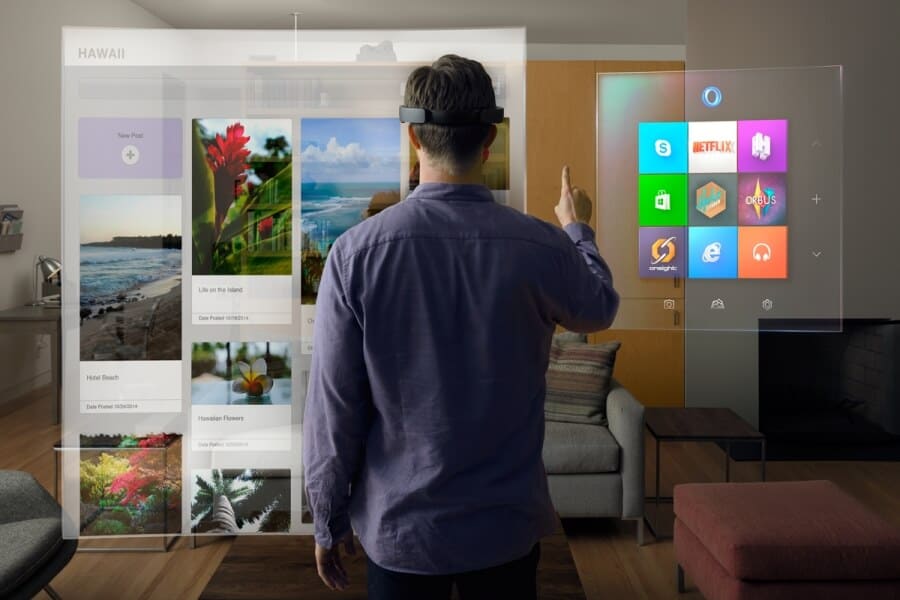There is a new breed of technology which seamlessly blends the digital and physical worlds. Augmented reality, which is not to be confused with virtual reality, presents a view of the world which is augmented by computer-generated sensory input such as sound, video, graphics or GPS data. It blurs the line between what’s real and what’s computer generated by enhancing what we see, hear, feel and smell.
On the spectrum between virtual reality and the real world, augmented reality is a bit closer to the real world. Virtual reality replaces the real world with a simulated one. It creates a fully immersive, computer generated environment that is distinctively separate from what we experience in real life. While, augmented reality just enhances what we already experience.
Microsoft HoloLens
In many ways, augmented reality is changing the way we view the world. This cutting-edge technology allows the environment around us to become interactive and digitally manipulable. At the forefront of the augmented reality revolution is Microsoft’s HoloLens, which allows users to pin holograms to their physical environment.
Microsoft HoloLens is the first fully untethered, see-through holographic computer. It enables high-definition holograms to come to life in the physical world, seamlessly integrating with physical places, spaces and things. It unlocks new ways to create, communicate, work and play.
When we think of the more traditional ways of computing, we think of sitting behind a screen, which can act as a barrier and cuts us off from the world around us. Without a screen to touch or a mouse to click, the HoloLens provides a more natural way to interact with technology. You can create and shape holograms with gestures, communicate with apps using voice and navigate with a glance. It allows users to work in a way that has never been done before. This opens up a whole new world of possibilities.
Navdy
Another example of augmented reality is an in-car device that projects smartphone information at eye level called, Navdy. Their tagline is, “it feels like driving in the future”. It is designed under the premise that most drivers use their smartphones while driving. They’re texting, using their apps and answering calls, all which can create unsafe driving conditions. As an alternative to mounting a cell phone on the dashboard, Navdy uses a small projector to display pertinent information six feet in front of the driver’s line of focus.
The system uses natural touchless gestures to operate it. You can swipe left to answer or a call, or right to dismiss a notification. Unlike using a smartphone while driving, users no longer have to look down to fumble with buttons or touch screens. It also uses voice recognition to allowing drivers to make phone calls, text or even tweet from the road. Any notification on your phone (text, social, etc.) can be displayed, read aloud or disabled entirely.
RideOn
Finally, RideOn offers augmented reality ski goggles that project data and graphics on to the snow in front of the wearer. “We wanted to find our locations on a ski resort map instantly, or to quickly contact each other when we’d get separated. We wanted to do these things without having to take our gloves off, or use our phones,” said Alon Getz, CEO and cofounder, on why they created the goggles.
RideOn’s features let users interact with friends and communicate using audio and video. You can post videos and stats online and throw virtual snowballs. It can also be used for navigation, allowing users to see their location on a map and find local ski lodges, restaurants and bars. You can even locate ski lifts and check queue wait times, all while keeping your hands free and warm in your gloves.
Augmented reality is just one way that No Interface is the New Interface. In a world where devices will tap, buzz, pulse and even warm their wearers, technology is evolving in ways that open up entirely new possibilities. The question is, are we ready for the augmented reality revolution?
Support us!
All your donations will be used to pay the magazine’s journalists and to support the ongoing costs of maintaining the site.
Share this post
Interested in co-operating with us?
We are open to co-operation from writers and businesses alike. You can reach us on our email at cooperations@youthtimemag.com/magazine@youthtimemag.com and we will get back to you as quick as we can.









